#1750s Italy
Text
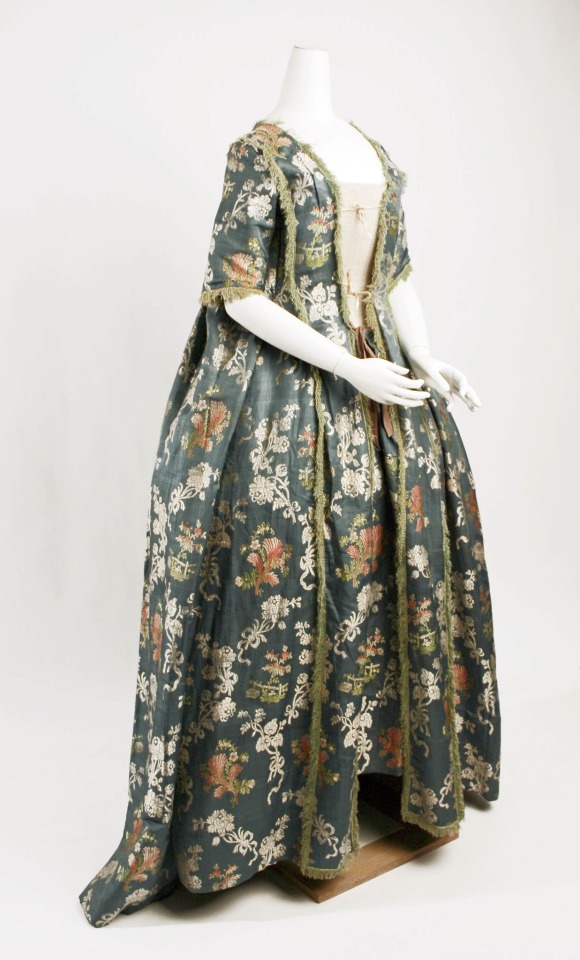
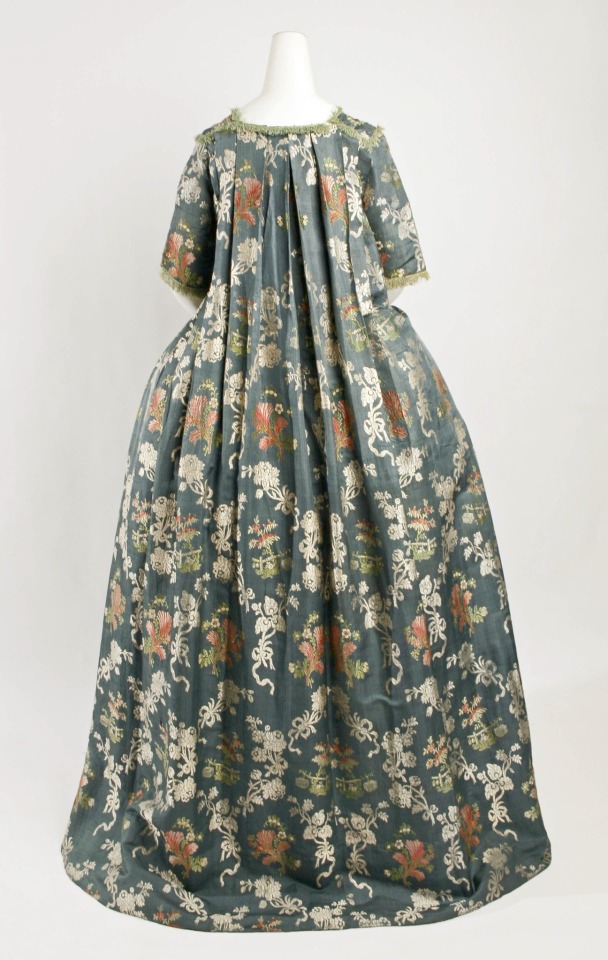
Green Embroidered Silk Dress, 1750-1775, Italian.
Met Museum.
#green#embroidery#womenswear#extant garments#dress#silk#1750#1750s#1760s#1770s#1750s dress#1760s dress#1770s dress#1750s extant garment#1750s Italy#1760s Italy#1770s Italy#1760s extant garment#1770s extant garment#italian#met museum
173 notes
·
View notes
Text

"Venetian Woman With A Beauty Spot” by Pietro Longhi, 1755
388 notes
·
View notes
Photo
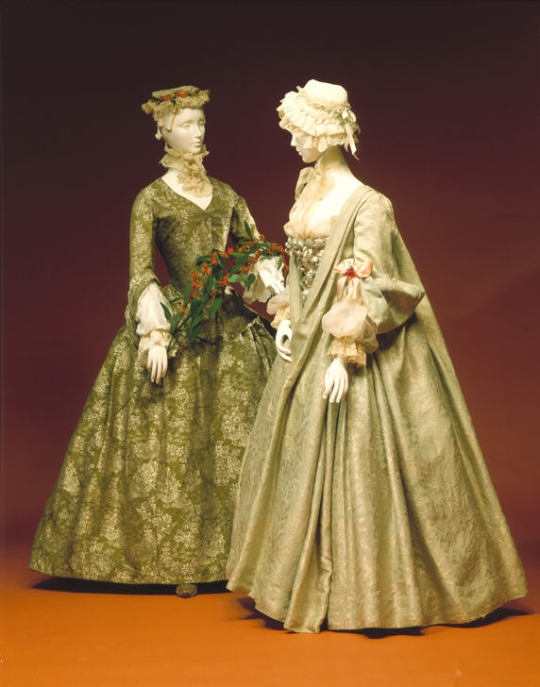
Dress (Left) & Robe Volante (Right)
c.1750 & 1700-1735
Italy & France
Late in the reign of Louis XIV, loose-flowing gowns with pleats gathered at the back neckband were worn as undress wear by daring ladies who liked the ease and comfort of this garment. The famous actress Madame Dancourt popularized these gowns by wearing one in Terence’s Andria, after which such gowns were often called andriennes. As the style developed the gathers were formalized by being drawn into one or more flat pleats, and a dome-shaped hoop or pannier was worn to extend the material around the wearer. When a lady moved, air was trapped under the hoops and she appeared to be floating; thus the name robe volante. This type of dress is often erroneously called a "Watteau sack," despite the fact that Antoine Watteau had little to do with the creation or dissemination of the fashion. According to the Mercure de France, by 1729 robes volantes were "universellement en règne, on ne voit presque plus d’autres habits" (universally in vogue, one hardly ever sees any other kind of dress).
The MET (Accession Number: 26.56.47a–g) (Accession Number: C.I.50.40.9)
#dress#fashion history#historical fashion#1700s#1750s#robe volante#18th century#green#silk#floral#flower print#france#italy#ancien regime#the met
389 notes
·
View notes
Text
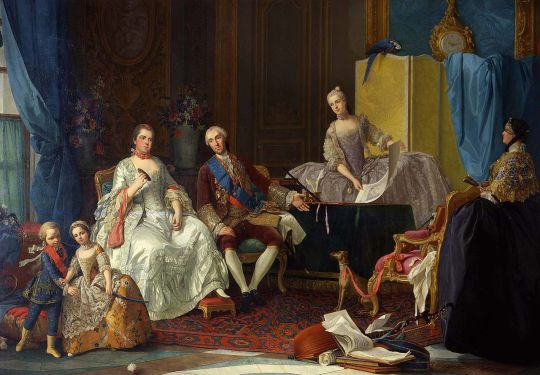
"The Family of Philip, Duke of Parma", 1755, Guiseppe Baldrighi, Galleria Nazionale, Parma.
Felipe de Borbón y Farnesio was the Duke of Parma from 1748 to 1765, and also the subject of one of my favourite portraits of the whole 18th century (from a set of 3, I will post those another time). The second son of King Philip V of Spain and Elisabeth Farnese, he became the Duke of Parma, that had been ruled by his mother's family for generations, via the Teatry of Aux-la-Chapelle in 1748, founding the House of Bourbon-Parma.
In this portrait we can see Philip sitting next to his wife Louise Elisabeth of France, the eldest daughter of Louis XV of France. They didn't have happy marriage, and she died of smallpox in 1759 at 32 years old.


Standing behind them there's their daughter Isabella of Parma, here wearing a lilac robe de cour, she would later marry Marie Antoinette's older brother, Holy Roman Emperor Joseph II, and would become very close (some people think that suspiciously close) to her sister in law Maria Christina. She died of smallpox after a difficult birth followed closely by two miscarriages at the age of 21.

At the front there are the Ferdinand (later Duke of Parma) and Maria Luisa (future wife of Charles IV and then Queen of Spain, yeah her cousin because of course).
At the front there's Ferdinand and Maria Luisa (aren't they the CUTEST?!). Both of them were born in 1751, and she's keeping his toy sword away from him, playing and pissing him off, like all siblings should. Ferdinand would become the Duke of Parma in 1765 at 14 years old and be later married to his bother in law's sister Maria Amalia of Austria. In 1801 he ceded the Duchy of Parma to France in the Treaty of Aranjuez.
Maria Luisa of Parma would become the Queen of Spain since she married Charles, then Prince of Asturias in 1765. He was mainly interested in hunting and mechanics and she in state affairs, so she became an influential and dominant figure in court. If this telenovela is not already sad enough for you, her father died unexpectedly in 1765 in Alessandria after having accompanied her to sail for Spain to be married to the Infante Charles.

There's also the profile figure of Marie Catherine de Bassecourt y Thieulaine the children's governess. She was a maid of honour of Phiilip's mother Elisabeth Farnese, and she joined Maria Luisa when she went to Spain and remained in the Spanish court since then. In 1765 Philip gave her the title of Marchese of Borghetto, thanking her services and merits.
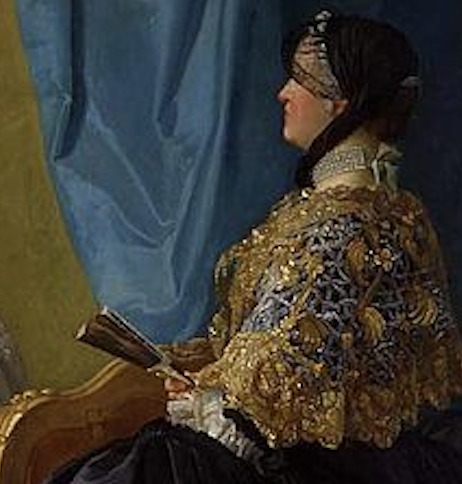
And finally, some pets and music. Didn't find anything about the dog nor the bird BUT I love them both. Especially the super fancy collar.
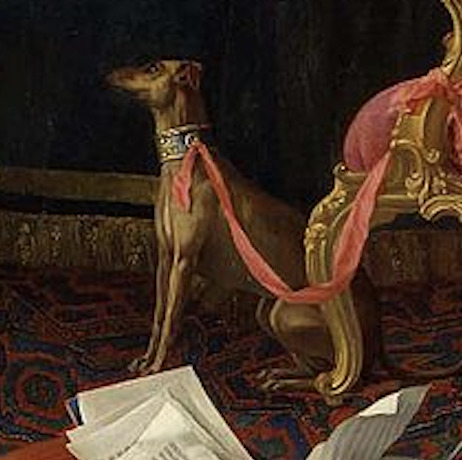


#1750s#1755#italy#spain#parma#duke of parma#guiseppe baldrighi#philip duke of parma#menswear#womenswear#spanish nobility#portrait#family portrait#art#18th century art
53 notes
·
View notes
Photo

Modern Rome, Giovanni Paolo Panini, 1757
Oil on canvas
67 ¾ x 91 ¾ in. (172.1 x 233 cm)
The Metropolitan Museum of Art, New York City, NY, USA
#art#painting#giovanni paolo panini#baroque#18th century#interior#1750s#oil#rome#italy#italian#the met
73 notes
·
View notes
Text
Tarot & Divination...
The history of tarot cards and their use for divination and spellwork is a fascinating subject that spans several centuries. While the exact origins of tarot remain somewhat obscure, there are recorded instances of tarot being used for divination and the earliest known tarot decks date back to the 15th century.

The earliest known tarot decks, such as the Visconti-Sforza deck (created around 1440), were initially used for playing card games in Italy. These decks consisted of four suits (cups, swords, coins, and batons) and featured additional cards called "trumps" or "triumphs," which later evolved into the 22 Major Arcana cards in modern tarot decks.
The use of tarot cards for divination and spellwork began to emerge in the 18th century. One of the earliest recorded instances of tarot being used for divination comes from a French manuscript dated around 1750, which describes a method of tarot card reading. This manuscript, known as the "Pratesi Cartomancer," outlines a system of drawing cards and interpreting their meanings based on their position in the spread.
Another significant figure in the history of tarot divination is Jean-Baptiste Alliette, also known as "Etteilla." In 1770, Etteilla published a book titled "How to Entertain Yourself with a Pack of Cards," which contained instructions for using tarot cards for divination. Etteilla is often credited with popularizing the idea of tarot as a tool for fortune-telling and spiritual guidance.

The use of tarot for divination and spellwork gained further prominence in the late 19th and early 20th centuries, particularly within the context of occult and esoteric societies. The Hermetic Order of the Golden Dawn, a secret society founded in 1888, played a significant role in shaping modern tarot interpretation. Members of the Golden Dawn, such as Arthur Edward Waite and Aleister Crowley, created their own tarot decks and developed complex systems of tarot symbolism and interpretation.
Waite, in collaboration with artist Pamela Colman Smith, created the Rider-Waite-Smith tarot deck in 1909. This deck became one of the most popular and influential tarot decks in the world and is still widely used today. Crowley, along with artist Lady Frieda Harris, created the Thoth tarot deck in the 1940s, which incorporated Egyptian and Kabbalistic symbolism.
Throughout history, there have been numerous anecdotal accounts of tarot divination providing accurate and meaningful insights. However, the effectiveness of tarot as a divination tool has not been scientifically proven. Skeptics argue that the perceived accuracy of tarot readings can be attributed to factors such as cold reading, confirmation bias, and the Barnum effect (the tendency to accept vague or general descriptions as specifically applicable to oneself).
Despite the lack of scientific evidence, many practitioners of tarot believe in its power as a tool for self-reflection, personal growth, and spiritual guidance. They view tarot as a means to tap into intuition, explore the subconscious mind, and gain insights into life's challenges and opportunities.
In conclusion, while tarot cards were not originally created for the purpose of divination or spellwork, their use for these practices emerged in the 18th century and gained prominence in the late 19th and early 20th centuries. The history of tarot is intertwined with the rise of occult and esoteric movements, and the creation of influential tarot decks by figures such as Waite and Crowley. Although the effectiveness of tarot divination has not been scientifically proven, many individuals find value in using tarot as a tool for personal growth, self-reflection, and spiritual exploration.
21 notes
·
View notes
Note
hi!! big fan of your blog. you really changed my succession viewing experience and i can't wait to rewatch after reading the recs you've put up!
that being said, i read megan garber's piece in the atlantic about the animal imagery/darwinian implications in the show and really loved it (as a biologist with an interest in sociology lol). do you have any specific reading material relating to the topics in that piece? i'd just love to read more but not super sure what i'm even asking/looking for, so feel free to ignore!
hi! so, there's quite a large body of literature in history of biology that deals with the politics of evolutionary theory, including darwinism. you can read these in any order, though i would recommend starting with bob young's 'malthus and the evolutionists: the common context of biological and social theory' if you haven't already encountered it. this was a signal essay in historically grounding the argument that darwinian evolutionary theory read victorian industrial capitalism and malthusian population anxiety into the natural world, which was why it appealed to victorian men of science in a way that previous theories of evolution (sometimes referred to as species transformation or transmutationism, or transformisme / transformismo in france / italy) hadn't. bob was a marxist historian at a time when history of biology had been largely written by working scientists and naive positivists, and his methodological influence continues to be felt in the field today. anyway, these are only starting points and are centred on france and britain, and also i excluded p*ter b*wler because i hate his ass:
the politics of evolution: morphology, medicine, and reform in radical london, by adrian desmond
utopia's garden: french natural history from old regime to revolution, by emma spary
the age of lamarck: evolutionary theories in france, 1790–1830, by pietro corsi
l'introduction du darwinisme en france au xixe siècle, by yvette conry (<- i can't remember whether this was translated into english, sorry)
faces of degeneration: a european disorder, 1848–1918, by daniel pick
darwin: the life of a tormented evolutionist, by adrian desmond and james moore
the cuvier-geoffroy debate: french biology in the decades before darwin, by toby appel
evolution before darwin: theories of the transmutation of species in edinburgh, 1804–1834, by bill jenkins
the spirit of system: lamarck and evolutionary biology, by richard burkhardt
the meaning of evolution: the morphological construction and ideological reconstruction of darwin's theory, by robert j richards
the great nation in decline: sex, modernity, and health crises in revolutionary france, c. 1750–1850, by sean quinlan
lamarck, the mythical precursor: a study of the relations between science and ideology, by madeleine barthélemy-madaule
victorian sensation: the extraordinary publication, reception, and secret authorship of vestiges of the natural history of creation, by james secord
93 notes
·
View notes
Note
LWA: Going back to a very old conversation, I suddenly realized that Bishop /isn't/ the only one of Aziraphale's "jobs" we haven't seen yet. The other one is garden designer ("deziner"). I think we all just skipped over that and said, yeah, at the Dowlings. But this is from 1941! Assuming he was sticking around England, the most logical time for Aziraphale to be pursuing this line of work would be the eighteenth century, which is the great age of English landscape gardens.
It also subverts fanon a bit. I know that everyone assumes that Crowley has a gift for gardening, but even in the series he knows nothing about plant care and doesn't seem to be aware that he has anything to learn. I've always found the thought of TV!Crowley trying to garden "the human way" to be hilarious, frankly: if he doesn't get why TV!Aziraphale does magic tricks or tries to learn French, he's probably going to have an equally hard time getting why he should go out and weed, instead of just snapping his fingers and making the weeds go poof...
fuck it LWA let's go two-for-two (and my profuse gratitude that it's a less head-scratchy one, thank you)✨
that's a bloody good point; first thing, i always took these to be in chronological order - that's logical, right?

so we have a huge gap between 537AD, and 1800 (presuming of course that aziraphale wasn't a bookseller before he opened the whickber street shop). i love the idea that if aziraphale was in england at the time of being a garden designer, and that it would be around this time period - stepping away from the more french-style landscaped order and neatness, and reviving it to brought back to blend in with nature... plus, the temples!!!
(and here is where i get duly ensconced in looking at pictures of rievaulx terrace and chiswick house)


if he wasn't in england though, i reckon he could have been in italy, because if there were some plans for a minisode placing them in 15th century italy, i feel like some of the design concepts/terminology from this period would fit with aziraphale? god knows im not an expert on historical horticulture, especially that from the italian renaissance, but its a school day - the concept of the villa/house being placed above the gardens for the best view from either point feels pretty on-point. not even going to pretend that i didn't lift this from wikipedia, it just felt too apt:

furthermore, if we do accept that that list is in chronological order, i wonder where aziraphale would have fit in being a bishop between, say, 1750 - 1800? at best?
as for crowley - look. i love the idea in a human AU context that crowley would be a keen gardener, and i do like the thought process that, in canon, we see some kind of sentimentality from him where his plants are concerned (not sure why else he would choose a select few to keep in his car - not if they would otherwise have a good home to go to). but yeah, i otherwise cant quite reconcile crowley with being the demonic equivalent of charlie dimmock - although i bet he gets a kick out of shouting at old ground force reruns from time to time✨
23 notes
·
View notes
Text

,, ♡ ︰the little mermaid timeline﹒🪸 ୨୧ ˖˚⊹
Atlantica is located in the Mediterranean Sea (which is canon as stated in 2019 in the official Disney Princess Youtube), which is a sea connected to the Atlantic Ocean. It was first founded thousands of years ago by the Greek God Poseidon, God of the seas, storms, earthquakes, and horses. He and Amphitrite then had Triton who was assigned to become King of the Seven Seas and ruler of the Kingdom of Atlantica.
Atlantica is one of the many peaceful underwater kingdoms where King Triton resides with his daughters: Attina, Alana, Adella, Aquata, Arista, Andrina and Ariel. It is the strongest underwater kingdom in existence and where mermaids seek refuge when danger lurks outside. Atlantica is protected by a magical shield created by Triton's trident, making it invisible to humans and impossible for creatures such as sharks to approach. Only mermaids and harmless animals are welcome here.
,, ♡ ︰ancient times﹒🪸 ୨୧ ˖˚⊹
Poseidon is born to Cronus and Rhea.
Atlantica is formed and becomes Poseidon's domain.
Poseidon meets Amphitrite.
They have Triton and he is named King of the Seven Seas and becomes ruler of Atlantica.
Poseidon and Amphitrite mysteriously disappear.
,, ♡ ︰modern times﹒🪸 ୨୧ ˖˚⊹
King Triton meets Athena in 1517 and the two wed in 1520, thus Athena becomes Queen Athena. They do not bear children until much later.
Ursula (born 1750), meets Triton in 1768 and through a series of events, ends up living at the palace. She is banned in 1782 for reasons unknown to everyone except Triton and Athena.
Attina is born 1789 (In a monarchy point of view, she is next in line to become Queen of Atlantica. However, as they are all immortals, it's hard to pinpoint how that would happen.)
Alana is born in 1790.
Adella is born in 1791.
Aquata is born in 1792.
Arista is born in 1793.
Andrina is born in 1794.
Ariel is born on December 18th, 1795.
Eric is born on July 16th, 1793.
Athena passes away in 1800, after being crushed by a pirate ship and music is then banned from Atlantica.
Music returns to Atlantica in 1810, during the events of The Little Mermaid: Ariel's Beginning.
The events of The Little Mermaid happen during the year 1812 (in May-June, when Ariel is 16 and Eric is 18), where she meets and falls in love with Eric. She marries him the year after in June of 1813 (when she is 17 and he is 19) and becomes future Queen Consort of Italy as Eric's kingdom is located in Sardinia, Italy, making him Prince of Italy (this has been up for debate. however, in BOTH the original novel and the movie, it is HEAVILY IMPLIED that the kingdom is located in a Mediterranean country, more than likely Italy, despite the writer being Danish).
Ariel becomes pregnant with Melody in May of 1814 and Melody is born on February 27th of 1815.
The events of The Little Mermaid II are set in February-March of 1827.
,, ♡ ︰trivia﹒🪸 ୨୧ ˖˚⊹
As Ariel's family ( except Athena ) are all descendants of Poseidon, a God, they are all demigods and immortals.
The trident can only be used by Triton or any of his descendants (hence why Melody could get ahold of it).
Each sister represents a different sea: Attina - Bering Sea, Alana - Black Sea, Adella - Mediterranean Sea, Aquata - Coral Sea, Arista - White Sea, and Andrina is the Caribbean Sea, with Ariel being the Red Sea.
#( `ε´ ) 𓂃 𝑺𝑬𝑵𝑻 ( … ) ♡ ariel ‣ study.#mutuals are free to reblog !!#the birthdays are purely bc i want a*riel to live in the regency time#but it's up to anyone's interpretation since the movie isn't super specific with their clothing
18 notes
·
View notes
Text
The Only Place Some Experienced Freedom in Ancient Greece - or, the Cult of Dionysus
The term cult in a classical context does not have the same meaning as it does today. While the whole of the Greek World had the same general beliefs and faith in a range of gods, special or more specific worship varied from city to city. The focus of these cults ranged from perhaps a specific myth, to a mythical hero, or even sometimes a real individual. Most cults might have been out in the open with many city residents being members, but others were exclusive and secretive.
Unfortunately, like most things at this time, many cult practices were reserved for the more elite classes. Elite being non-slave males that had citizenship. One of the biggest exceptions to this rule was the Cult of Dionysus.
Dionysus, also known as Bacchus or Liber, represented freedom and liberation for those who had none. These brief moments of worship and frenzy allowed the unmentionable parts of the Greek World to experiment with empowerment for what was most likely the only time in their lives.
This cult has text evidence dating all the way to the Mycenaean Era (1750-1050 BCE) and lasted for centuries up until the times of the Romans. It was uniquely open to women, slaves, outlaws, and non-citizens. There, they lost themselves to wine, hallucinogenics, and chaos in larger organized festivals and small secret meetings.
The largest of these gatherings was an annually held celebration in the city of Dionysia. Every March, everyone was invited to partake in this festival, where officials even allowed foreigners in and released prisoners and slaves for this exclusive event.
There were drinking contests, theater shows (Dionysus was also the god of theater), and sacred ceremonies all performed for the same cause.
As Rome caught onto the cult and its practices, their own version started appearing. Now by around 200 BCE, women hosted female exclusive gatherings called the bacchanalia (Pretty irrelevant, but a pretty good song that has the same theme). Eventually, men were allowed in and this growing group met up 5 times per month.
Unfortunately, the Roman government began to feel threatened by these gatherings and banned any practice within Italy with the threat of severe consequences. Regardless, the cult lived on for long after this.
Anyway, the Cult of Dionysus goes to show that even in the most exclusive, misogynist, and classist societies, the human desire for freedom and liberation prevails - even if they need to meet in secret. In another post in the future, I might go into more detail about the initiation rites and what exactly happened during these celebrations.
#I know im a pretty poor writer#i just like to talk lol#greek mythology#greek gods#dionysus#ancient greece
8 notes
·
View notes
Photo
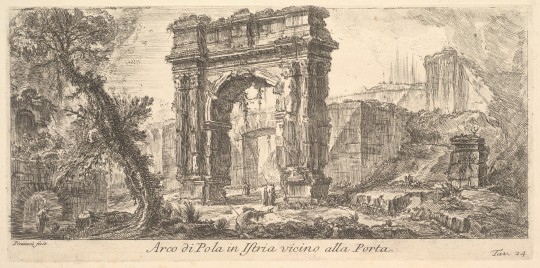
Plate 24: Arch of Pola in Istria near the Gate (Arco di Pola in Istria vicino alla Porta), from "Alcune Vedute di Archi Trionfali ed altri monumenti inalzati da Romani parte di quali se veggono in Roma e parte per l'Italia" (Some Views of Triumphal Arches and other monuments erected by the Romans, some of which are in Rome and some elsewhere in Italy). ca. 1750. Credit line: Harris Brisbane Dick Fund, 1937 https://www.metmuseum.org/art/collection/search/365395
#aesthetic#art#abstract art#art museum#art history#The Metropolitan Museum of Art#museum#museum photography#museum aesthetic#dark academia
4 notes
·
View notes
Photo

Caraco, 1750, Italy.
94 notes
·
View notes
Text
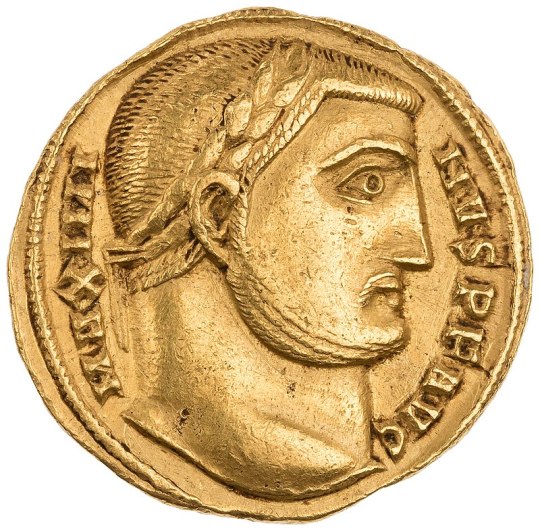
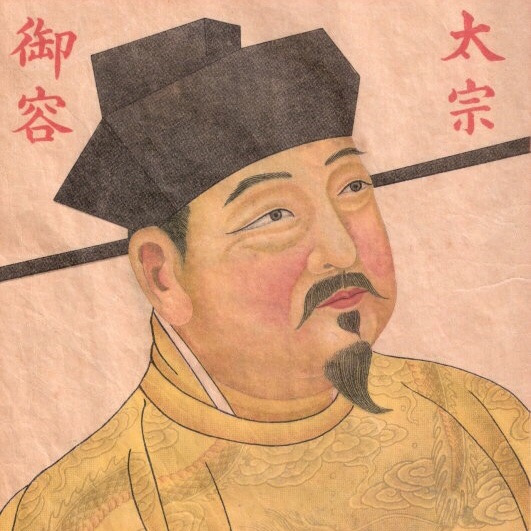
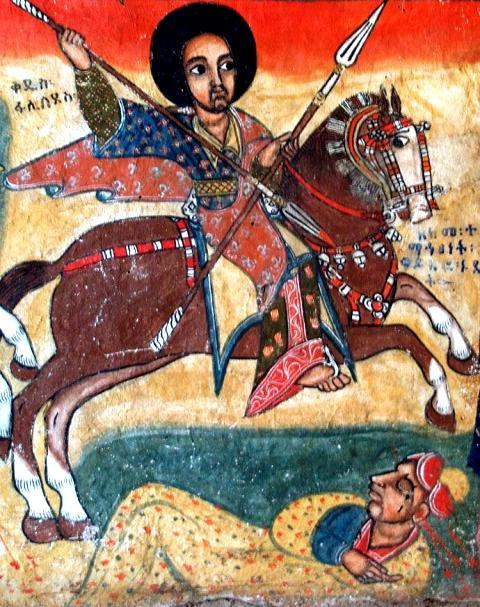
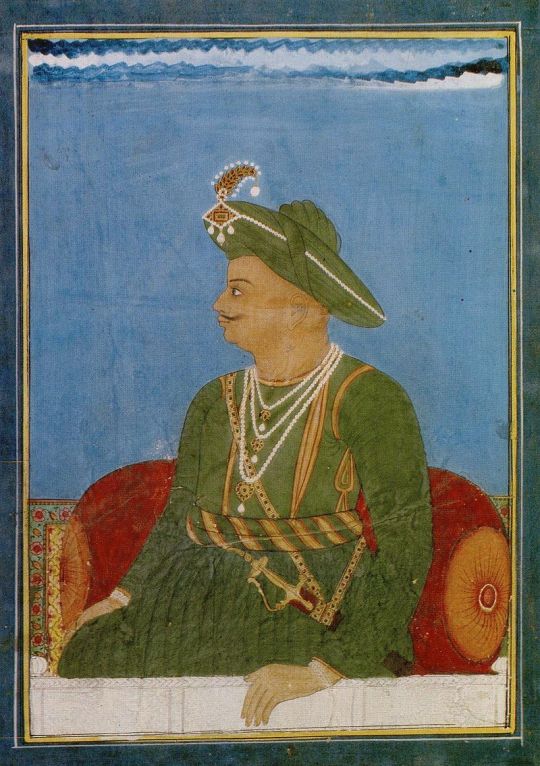
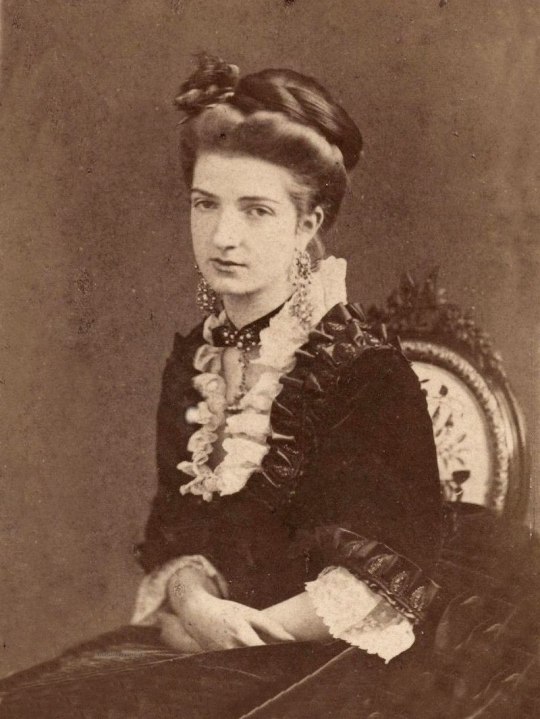





Royal Birthdays for today, November 20th:
Maximinus II, Emperor of Rome, 270
Taizong of Song, Emperor of China, 939
Fasilides, Emperor of Ethiopia, 1603
Tipu Sultan, Ruler of Mysore, 1750
Margherita of Savoy, Queen of Italy, 1851
Maria Letizia Bonaparte, Duchess of Aosta, 1866
Alexandra of Sayn-Wittgenstein-Berleburg, Countess of Pfeil, 1970
Sofia, Princess of Bulgaria, 1999
Umberto, Prince of Bulgaria, 1999
Theodora, Princess of Liechtenstein, 2004
#maximinius ii#taizong of song#tipu sultan#margherita of savoy#Alexandra of Sayn-Wittgenstein-Berleburg#Fasilides#Maria Letizia Bonaparte#sofia of bulgaria#prince umberto#theodora of liechtenstein#long live the queue#royal birthdays
6 notes
·
View notes
Note
Super random question, but is there like an actual history about how the kippah (the piece of clothing itself not the meaning) developed, because so far I've kinda headcanon'd it came from balding men wanting to protect their bald spot from the sun. It also always seems so flimsy, how are guys not losing it all the time?
Bfhdhdjdjsjs your headcanon is A++.
Tbh, I had to look it up, since despite thinking about it when I was younger, I never bothered to look it up. According to Jewish encyclopedia, through Wikipedia,
The Israelites might have worn a headdress similar to that worn by the Bedouins, but it is unknown whether a fixed type of headdress was used. That the headdress of the Israelites might have been in the fellah style may be inferred from the use of the noun צַנִיף, tzanif (the verb tzanaf meaning "to roll like a ball", Isaiah 22:18) and by the verb חַבָּש, habash ("to wind", compare Ezekiel 16:10; Jonah 2:6). As to the form of such turbans, nothing is known, and they may have varied according to the different classes of society. This was customary with the Assyrians and Babylonians, for example, whose fashions likely influenced the costume of the Israelites—particularly during and after the Babylonian Exile.[42] [...]
I imagine that, at the beginning, it was meant to protect the skin from the sun's heat, like the Bedouin used it, and given what is customary within Babylonian and Assyrian societies, it probably had also a role in distinguishing your social class (which is still sort of a thing! For insurance, in general black kippahs are a staple of Haredi Jews). That being said, on the Assyrian stelees Jews are not shown to wear any kind of head dress, which might mean they weren't in vogue during that time (or that the one making the stelee got lazy 🦥).
Now, as for the change into a skullcap, I imagine it was a change in fashion, which stuck for the longest and thus became the norm, yet it still differs among different Jewish communities:
The Black Velvet Kippahs are, as I said, of the ultraorthodox Jews, and even they have variation: See how one has a rim and one doesn't.



Haredi children might also have velvet Kippahs with embroidery or other colors such as navy blue.
Yemenite Kippahs tend to have a dark color and embroidery at the bottom, while there are also knitted Kippahs used by less orthodox factions of Judaism, and they come in many colors and many designs.
In other words, it's either a community thing (think breslov, bukharan Jews, and haredim) and/or a fashion thing (think suede and crochedet Kippahs used by reform and modern Orthodox Jews).


A good guide for this sort of thing is this the following image, which shows a series of changes of Jewish male headdress

Jewish Head-Dress at Various Periods.1, 2. England (13th cent.). 3-5. Germany (13th cent.). 6-8. France (13th cent.). 9. Rhine Provinces (13th cent.). 10. Constance (1417). 11. Holland (15th cent.). 12. Italy (15th cent.). 13, 14. Germany (15th cent.). 15-17. Rhine Provinces (15th cent.). 18, 19. Worms (16th cent.). 20. Germany (16th cent.). 21. Worms: "Judenbischof" (17th cent.). 22. Swabia (17th cent.). 23. Frankfort-on-the-Main (1630). 24, 25. Poland (1765). 26, 27. Warsaw (1825). 28. Cracow (17th to 18th cent.). 29. Podolia (1750). 30. Tunis (1800). 31. Morocco (1800). 32. Moravia (1800). 33. Russia (modern). 34. Caucasus (modern). 35. Russia: Karaite (modern). 36, 37. Tunis (modern). 38. Russia: "Yarmulka" (modern). 39. England: rabbinical (modern).
As you can see, the headdress changed a LOT until it reached today's look, which is probably a product of changes in fashion, price of fabric, and probably also emancipation etc. and the desire to blend in better into gentile societies.
Then again, I'm no expert so I might be spewing nonsense XD.
Anyway, I hope this was helpful to some degree!!
10 notes
·
View notes
Text
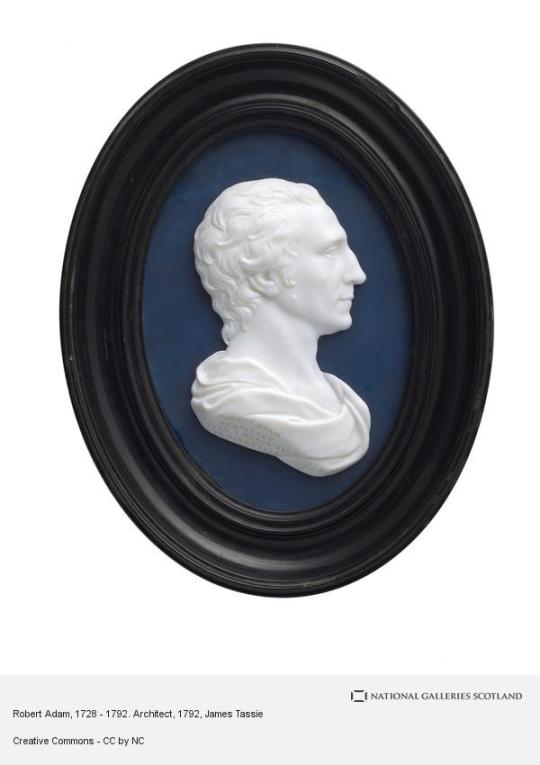



On July 3rd 1728 Robert Adam, the Scottish architect, furniture and interior designer, was born in Kircaldy
Robert Adam was the son of a Stonemason, William a stonemason who took up architecture, the family moved to Edinburgh when Robert was eleven, where his father had become the most popular architect in Scotland.
He attended The Royal High School in Edinburgh and was noted as having a "feeble constitution" His education continued at The University of Edinburgh where his studies were interrupted in 1745 due to wee bit of upheaval when the Jacobite Army of BPC arrived and occupied the City. Added to this he fell seriously ill at the end on the year and failed to graduate. On his recovery from illness in 1746, he joined his elder brother John as apprentice to his father. He assisted his father on projects such as the building of Inveraray Castle and the continuing extensions of Hopetoun House, his father died in 1748 and Robert and his brother ran the family firm now called Adam Brothers.
In 1750 Robert decided he needed to witness the architecture around Europe and departed on his "Grand Tour" in France and Italy. He studied widely the classical Roman ruins and increased his drawing skills.
On his return he opened his own architectural practice in London and soon became established as one of the most fashionable designers amongst the High Society. His Practice was timely as there was a renewed interest in England for all things Classical and the “Palladian Movement” (Based on the proportional architecture of the Italian Andrea Palladio) had just firmly taken hold. Adam was no slavish Palladian however and his Style has become known as “neoclassical”. He adapted and developed ancient styles rather than simply copying them.
As Adam was more often than not asked to renovate existing buildings much of his work was concerned with interiors. He was obsessive over every detail and designed everything himself down to plasterwork and fireplaces. He moved beyond Roman Style and was influenced by Greek, Byzantine and Italian Baroque design.
Adams work in Scotland include the Royal Exchange, in Edinburgh's High Street on the Royal Mile, The Royal Infirmary, Glasgow, Register House, Edinburgh and The Old College quadrangle at the University of Edinburgh.
In England he designed my favourite, Pulteney Bridge in Bath, as well as Kedleston Hall and Marlborough House, Brighton.
I think I have featured most of these buildings previously in posts so would like to showcase some of the meticulous interior work that Robert Adam was known for. As I've said before I am not a fan of the country houses, the places that reek of wealth, give me a ruined castle any day, but you have to admire the work that went into these interiors.
As seen in the first picture, Kenwood Library was added to Kenwood house in London by Adam between 1767-69 and you have to admit, it is beautiful as is The Marble Hall at Kedleston Hall, both these are open to visitors through English Heritage and National Trust respectively. Back in Scotland I couldn't finish this post without mentioning Red Drawing Dining room at Hopetoun House, made famous by the fictional Duke of Sandringham in TV Series Outlander.
13 notes
·
View notes
Photo
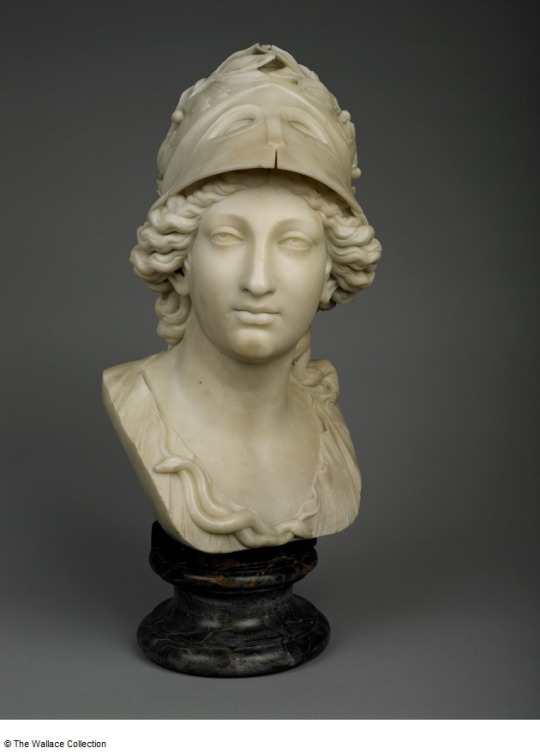
Minerva, Italy, 1750-1800
#minerva#athena#italian#1750#1800#1750s#1800s#1700s#18th century#19th century#neoclassical#sculpture#statue#art#bust
48 notes
·
View notes